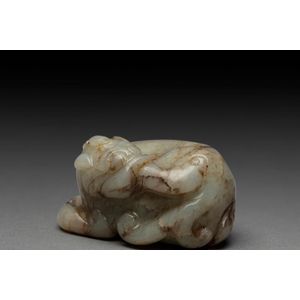Ming Dynasty Celadon Jade Xiezhi Carving
A celadon jade carving of a mythical beast Xiezhi, Ming Dynasty (1368-1644) the recumbent mythical beast is carved with head turning left, biting his left hind hoof, the other three legs tucked under its body and scroll-like tail flicked over its haunches, the stone is with a pale celadon tone. 4.4 cm long. Provenance: An important private collection, Sydney, Australia
You must be a subscriber, and be logged in to view price and dealer details.
Subscribe Now to view actual auction price for this item
When you subscribe, you have the option of setting the currency in which to display prices to $Au, $US, $NZ or Stg.
This item has been sold, and the description, image and price are for reference purposes only.
- Ming Dynasty - The Ming Dynasty was a ruling dynasty of China from 1368 to 1644. It succeeded the Yuan Dynasty and preceded the Qing Dynasty. The Ming Dynasty was established by Zhu Yuanzhang, a former Buddhist monk who became a rebel leader and eventually overthrew the Mongol Yuan Dynasty. During the Ming Dynasty, China experienced a period of relative stability and prosperity. The government was centralized and bureaucratic, with the emperor at the top of the hierarchy. The Ming Dynasty is known for its cultural achievements, including the development of porcelain, the invention of movable type printing, and the construction of the Great Wall of China.
- Important - Important is a word used in the antique trade to indicate an object should be ranked above other similar objects, and is therefore more valuable.
The object could be considered important because it is by a famous designer or maker, has been shown at a major exhibition, is of exquisite workmanship, is rare or is a "one-off", was made for an important patron, and so on.
Even further up the pecking order are objects that are described in catalogue descriptions as highly important or extraordinarily important.
This item has been included into following indexes:
